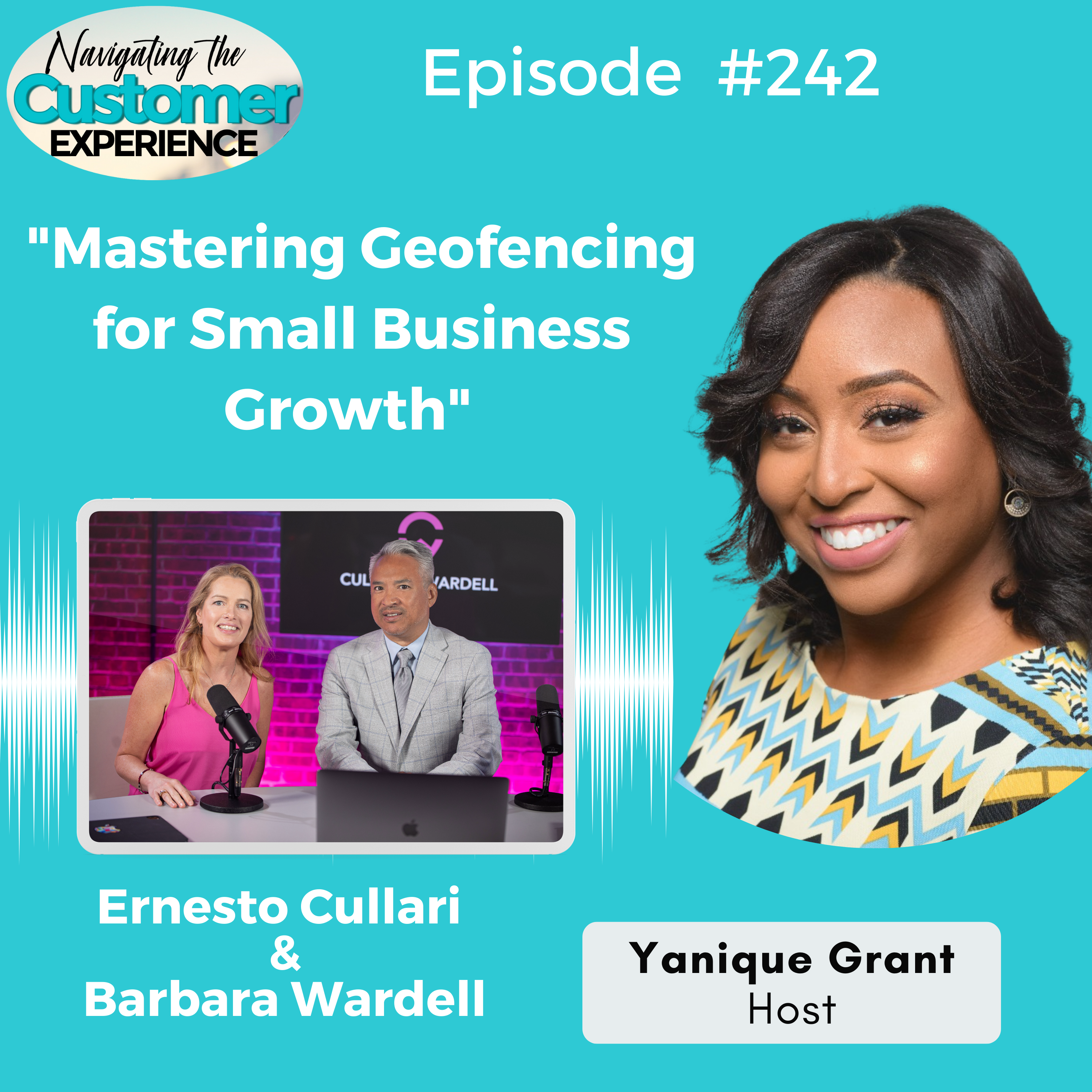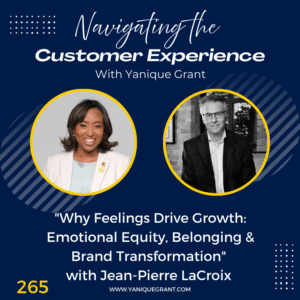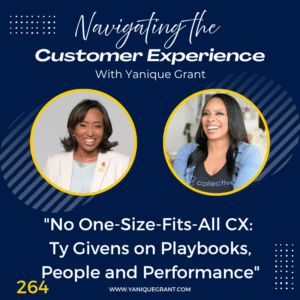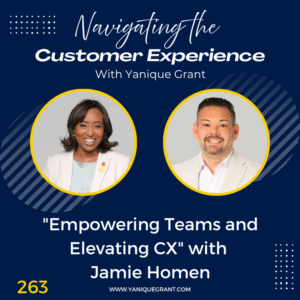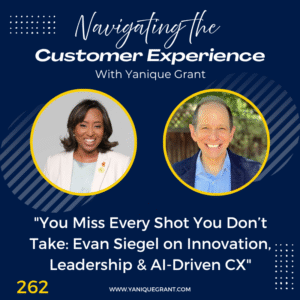Barbara Wardell and Ernesto Cullari run an agency that focuses on geofencing. This embraces a growth hacker mindset that strategically focuses on identifying and amplifying their clients’ strengths while pinpointing weaknesses in the competition, utilizing GPS location data. This approach results in a significant and measurable impact on foot traffic and online engagement, making their efforts truly game changing and successful.
Questions
· Now, we always like to ask our guests in their own words, if you could share a little bit about your journeys, how you got from where you were to where you are today.
· Can you share with our listeners in the most simplest layman terms, what exactly is geofencing?
· Organizations heavily invest in marketing, but then when the person comes to the organization to do business, case in point, let’s say you visited Starbucks, and you had to wait for 20 minutes just to get a cup of coffee. You’re extremely frustrated, because it’s just a small item, you should be in and out in the shortest possible time. How do you tackle that with your clients? Is that something that you deal with as well?
· Do you find that the behavior based on the geographic location or even the culture of the country, impacts how geofencing works?
· Now we’d also like to hear from both of you, what’s the one online resource, tool, website or application that you absolutely cannot live without in your business?
· Can you also share with me maybe one or two books that you’ve read? It could be a book that you read recently, or even one that you read a very long time ago, but it has had a great impact on you, whether personally or professionally.
· Now, can you also share with our listeners, what’s the one thing that’s going on in your lives right now that you are really excited about, either something you’re working on to develop yourself or your people.
· Where can listeners find you online?
· Now, we always like to wrap our episodes up by asking our guests, do you have a quote or a saying that during times of adversity or challenge, you’ll tend to revert to this quote if for any reason you get derailed or you get off track, the quote kind of helps to get you back on track. Do you have one of those?
Highlights
Barbara and Ernesto’s Journey
Me: Now, we always like to ask our guests in their own words, if you could share a little bit about your journeys, how you got from where you were to where you are today?
Barbara Wardell: Barbara shared that she and Ernesto met during Covid at a Halloween party, believe it or not, before they started their company together, they became friends. And her journey is she’s a mom of two, and she was in the medical industry, specialty medicines for a long time, and then Covid hit, and then she and Ernesto met at a Halloween party, became friends, and then they started Cullari & Wardell, a geofencing ad agency, and a little over two years, they’ve been killing it, so growing small businesses. So, they’re really lucky to do that.
Ernesto Cullari: Ernesto stated that as Barbara said, they met during Covid, they both have a medical background. For years, he was a Surgical OR Med Rep, so he would be working in the operating room with physicians utilizing novel technology to do abdominal body wall repair, post breast reconstruction after cancer and things like that. During the day, he moonlit as a professional songwriter, so he had songs on Disney radio, country radio, that he wrote for other artists.
And along that journey, he became a songwriter. So, the mystery during his creative time was always wondering how to sort of growth hack, how to break an artist out into the mainstream. And they had a lot of success doing that. Paulie Litt from the show Hope & Faith, ended up having a number one song on Disney radio, which they wrote for him, and then had a top 100 song, and then top 15 country music song that he wrote for an artist named Bailey Grey.
And so, it does lead them up to Covid, because when Covid struck, part of their content, so he got more into advertising and marketing, and a lot of their clients just dropped off. And the problem that needed to be solved was how do you rebuild foot traffic, particularly in a market where the government won’t let you open, when they do let you open, people are going to be slow to come back to retail.
So, what do we do?
So, putting that growth hacker hat back on to when he was a songwriter, he looked into geofencing, and that was about 4 years ago, and then 2 years into his journey of mastering, doing his 10,000 hours of studying geofencing technology, he and Barbara met, and it became a passion of theirs, and throughout their conversation, to help small businesses, to help them bring people back in.
People like the retail experience, people like the in-person experience, and geofencing is a powerful tool that uses satellite technology to draw virtual fences around locations of interest. It could be your competitors, and they use that to capture their devices to send ads to their devices when they come into one of their locations after seeing one of your ads, the satellite pings them and alerts them that a new GPS verified visit has taken place. And he and Barbara do about 5000 satellite verified visits in the US, Canada and Australia every month.
What is Geofencing?
Me: Now, for those of our listeners that are tapping into this episode when it’s broadcasted and they’re getting a chance to listen into this awesome content, can you share with them in the most simplest layman terms, what exactly is geofencing?
Ernesto Cullari: stated that in the simplest terms, it is a form of advertising that uses your phone and when you walk into a location that they’ve identified with a satellite, he’s drinking a cup of coffee at a coffee shop that he bought it at. And then in his surrounding areas, there’s about 7 other coffee shops. Well, if he wants to show why he’s better, he would use geofencing to draw a virtual fence around his competition. Once someone walks into a competing coffee shop with their mobile device, he can then capture their device and then send ads to their device. And the wonderful part is, is when after seeing his ad, come back to his coffee shop, he could say, “Wow, because of my ads, because I used geofencing to target their devices in my competition stores, I’ve therefore just measured 50 visits this month.”
So, it’s critical because none of us are made of money, and advertising dollars for the small business is scarce, so we want to use our money wisely. And big companies like Chipotle, Chipotle, by the way, the CEO of Chipotle just got hired at Starbucks.
Me: I saw that yesterday.
Chipotle during Covid, utilized, he thinks it was one of their vice presidents came up with this idea, “Hey, let’s use geofencing. I heard it works.” Well, during Covid, Chipotle was able to triple their curb side pickup from using geofencing. They saw where other people were picking up food, and then they decided to target those locations and let them know that, “Hey, Chipotle has curb side pickup.”
So, Chipotle did so well that Starbucks needs to learn from them. As you know, a lot of Starbucks locations have been closing throughout the country, and they picked off talent from Chipotle, and he has no doubt that that talented team is going to be helping Starbucks turn around, but geofencing is part of that story.
Me: So, now our listeners have a good idea of what geofencing is and also what your organization does.
How Does Using GeoFencing as a Marketing/Advertising Tool Affect CX?
Me: Now let’s tie all of that back into the customer experience, right? Because we’re all about navigating the customer’s experience. So, you have marketed and advertised to the organizations to say, hey, you can come to this organization based on the geofencing marketing initiatives that you’ve put in place. Now, can you share with me how it is that the customer experience is addressed in this for example, like with your clients, because I find, for example, people spend a lot of money on marketing and advertising, not sure what the cost point is for geofencing compared to traditional media like the radio or newspaper, if it’s significantly cheaper. But I find that a lot of times, organizations heavily invest in marketing, but then when the person comes to the organization to do business, case in point, let’s say you visited Starbucks, and you had to wait for 20 minutes just to get a cup of coffee. You’re extremely frustrated, because it’s just a small item, you should be in and out in the shortest possible time. How do you tackle that with your clients? Is that something that you deal with as well?
Barbara Wardell: shared that for their end, it’s the advertising end, they don’t deal with the customers per se. The places that people go with their smartphones is indicative highly of the products that they buy. So, when they go into a geofence, what they see is they’re open on an app, because they’re on apps or on the wide-open web, they’re not on Facebook, Instagram, Google. So, when they actually go into that geofence and they’re on an app, they will see an ad for one of their customers, and from that, if they toggle it or click it, they will see a map how to get there. Once they go into that store, whether it’s that day or 90 days later, the satellite will ping them. So, that part is their end. What they go into the store is on the customer itself of how they treat their customer. And Ernesto has some insight on that as well.
Ernesto Cullari: shared that when they do a consultation with a client, one of the first things they ask, they’re one of the largest advertisers for laundromats in the world, so small business owners have discovered that owning a laundromat is a very good business, you’re serving your community, you’re providing a great service, but it’s very important to set up realistic expectations. So, he and Barbara, when they consult a company, they want to find out even,
“What kind of doors you have?”
“Do you have doors that are particularly when moms and dads are coming in with their kids, are the doors automatic? Are they wide doors?”
“Are you operating new machines?”
Because they want to set up realistic expectations for the end consumer. So, when they work with one of their clients, they do ask them how their operations run. They’ve been very fortunate to attract top operators in communities across the US, but when it comes to restaurants and spirits companies and hotels and HVAC and doctors and things like that, service providers, they do want to make sure that the product that they say they’re offering is the end user experience that the customer has. But as Barbara said, it’s not their responsibility to make sure they do operations well, but they advise them, “Hey, get your operations down, and let’s make sure the promise that we give is matched with the in-store experience.”
Barbara Wardell: shared that that’s something they think that is very important. So, that’s why they do a lot of research before they take on a client. They ask them a lot of questions to make sure that they’re doing what they’re promising in their ads, because you don’t want that customer to come in and say, “Okay, this is not what the promise was, right?” Then they won’t come back.
Ernesto Cullari: shared that they’re concerned about their numbers; in order to do well for you, they need to be telling the truth. There needs to be truth in advertising, and they don’t want their numbers as a company to be impacted because they’re committed to delivering as much as 5000 visits a month, and if their clients are not on their end, providing the proper customer experience, it does impact him and Barbara. So, they’re very competitive, they want to make sure they uphold the things that they say they’re going to do, and they tend to advise their clients 100% of the time to do the same to make sure they’re matching the experience with their ad promise.
The Impact of Geofencing
Me: So, in the feedback that you just provided, it got me thinking to the fact that, do you find geofencing it’s most effective or impactful based on your geographical location. So, is it that you primarily operate in the United States, in North America? And do you find that geofencing would be different based on, let’s say, a customer who is in Nigeria, in Africa, or a customer who is in Kingston, Jamaica, in the Caribbean? Do you find that the behaviour based on the geographic location or even the culture of the country, impacts how geofencing works? Is that data that you’re able to provide as well to the clients?
Barbara Wardell: Yes. So, they’re right now in Australia, Canada and the United States, and there is a culture difference when you advertise in a different country, they found that a lot has to do, they do a lot of studies before they break into another country, to make sure that they understand the behaviours and kind of they do a listening device that kind of listens to the area to see, because they track mobile foot traffic, right? So, that’s one of the things that they do to work on their geofencing, so they already know when they go into that area, what the culture is like, and also talking to the customer as well to understand the area. And also, they do a listening device or a foot traffic study to understand the area that they’re targeting.
Ernesto Cullari: Agreed, Barbara said it perfectly. They do set up listening campaigns, and it’s basically a beacon to measure, he’ll give you an example, Australia, for listeners that haven’t been there, he and Barbara have not been there, but when they look at it via satellite, you have these communities that are densely populated, and then you have hundreds of 1000s of acres of wide open space. So, they really need to do due diligence and measure the amount of devices that are available in an area before they market to them. So now, they haven’t tested yet whether this works in Africa or South Africa, but right now, they’re for sure it works all throughout Asia and it’s a matter of so say, Nigeria, for example, they would have to set up a listening campaign, they would have to measure the amount of devices that are available and then determine what kind of devices are they. Are they iPhones, Samsungs and Androids, or are they flip phones and some other mixture of devices and that will impact what kind of the ads they use.
Me: All right. So, that definitely answers my question, and I think it will help to guide the listeners as well in terms of if they’re small business owners, or even working in organizations with small business owners that they can definitely identify if this is something that would benefit them and benefit creating more traffic for their organization, generating more customers and hopefully impacting their customer experience.
App, Website or Tool that Barbara and Ernesto Absolutely Can’t Live Without in Their Business
Barbara Wardell: When asked about online resource that they cannot live without in their business, Barbara stated that she thinks it’s the foot traffic study only because it gives them a lot of information before they even launch a campaign for any one of their customers. It is something that they can see a half hour before and a half hour after the customers, where they go from that that area, or that specific customer, and also for a year, they can go back for a year to look at that traffic and see where those customers go.
Ernesto Cullari: He thinks for himself, he has his hand in a lot of working on the creatives for clients. And even though there are wonderful platforms out there, like the whole Adobe Suite, which includes Premier, Photoshop, Lightroom and all that, and Adobe Illustrator, and he thinks they’re all great. But he likes the prosumer which are applications that anybody off the street could use. So, if you’re a small business owner or even a big business owner, and you want an application where you don’t need to go to your team or your assistant, you want to be able to do something yourself, Canva is a wonderful platform that he has actually, when he works in Canva after working in something like Adobe, his turnaround time sometimes in Canva is so much quicker because it’s made for dummies.
Canva is made for dummies. So, he loves Canva, and also, they manage designers, and those designers, they work in Creatopy, again, so that’s a prosumer, anybody off the street could use that website, it makes great looking html5 ads.
And again, as someone who manages creatives, if he doesn’t like something, can go into Creatopy, and he could fix it himself. So, he thinks no matter where you are in your journey as a business owner, whether you manage a fortune 100 company and you have to deal with your admin, your marketing men and women, or you own a small business and you have to do it yourself, or you’re hiring an agency like them, Canva andCreatopy, in addition to the Adobe Creative Suite, are just wonderful platforms.
Books that Have Had the Biggest Impact on Barbara and Ernesto
Ernesto Cullari: When asked about books that have had an impact, Ernesto shared that he read Confessions of an Advertising Man by Ogilvy, which he thinks is one of the greatest books on advertising you can read. But also, it’s not just advertising, it’s in general, if you’re someone who needs to communicate to the masses or to discrete audiences, small audiences, learning the art of communication is important, and he thinks Confessions of an Advertising Man, he have found invaluable.
In addition to Sun Tzu’s Art of War, sometimes you have to crush your competition, and you have to be able to have the stomach for it, and strategy is necessary. And Sun Tzu’s The Art of War he would also say. And then the Bible.
Barbara Wardell: She has to say one of her favorite is Wabi Sabi Love, it’s about being in the present and appreciating everything that’s in your life at that moment, because it could be gone tomorrow, and she’s had that experience, she’s read a ton of marketing books, but that’s one that’s close to her heart.
Ernesto Cullari: He shared that Yanique asked earlier about cost effectiveness, and the cost per acquisition and things like that. How does this compare to other forms of advertising? So, he’s sure a lot of listeners out there have for various reasons, could be for charity, could be for advertising, could be for marketing. They’ve engaged in Facebook, Google advertising to promote an event or product. So, he can tell you, doing the engagement using Facebook and then starting with other forms of advertising since then, and he can tell you that geofencing, pound per pound is the Mike Tyson, is the absolute Mike Tyson of advertising. Everyone else is a lightweight. There is no censorship.
So, if you run political ads, you will face no censorship of any sort on the geofencing side, unlike Facebook and Google, who will silence you if they don’t agree with your viewpoints. And in terms of reach and measurement, dollar for dollar, there’s just nothing as effective as geofencing.
So, on a $500, he doesn’t recommend only spending this, but on a $500 budget per month, you can end up with 20 people coming through your door. I do recommend for five-mile radius that you spend at least $1,000 on your market, that way, if you know the cost per customer, meaning how much money your average customer spends, you have the opportunity to 10 to 30x your return on investment depending on what the value of a new customer is for you.
In some of their verticals that they work with, the value of a new customer is $40,000 so on the $1,000 ad spend, if you gain one new client a month, that’s a quite impressive return on investment. For other clients they have in the laundry industry, some of their clients are worth 1200 to 2500 a year. So, if they send the 30, 40, 50 customers a month, then that again, is quite a handsome return on investment, agreed.
What Barbara and Ernesto is Really Excited About Now!
Barbara Wardell: When asked about something that they are really excited about, Barbara shared that they just launched which they’re really excited about, their dashboard for their clients so that they can go in and see the reporting instead of them emailing them their reports, so now that they can go into the system and actually on their time and actually look at and see their results of their campaign.
Ernesto Cullari: He shared that he’s excited about he and Barbara just got finished running a fundraiser from his mother’s orphanage in the Philippines. She operates what’s called Street Kids Philippine Missions, and she’s been there for 15 years with her husband, Matt, and they have rescued kids that were in danger of being sex trafficked, that were eating out of garbage cans, that were basically destitute. And it’s their 15th year, they just successfully raised $20,000 and that was simply an online campaign where they used their podcasting studio to talk about what his mom does, and Matt does there. And they’re pretty proud of being able to use their resources to help kids that face sex trafficking that would otherwise be destitute. And he would say he’s most happy and proud about that development.
Where can listeners find you online?
Website – www.cullarimedia.com
Quote or Saying that During Times of Adversity Barbara and Ernesto Uses
Ernesto Cullari: When asked about a quote to they tend to revert to, Ernesto shared from The Art of War, “He whose forces are of one mind will be victorious.”
Barabra Wardell: She shared that mainly, she always tells herself to be in the present moment and not get sidetracked by other things that are going on. But she can’t think of a quote right now.
Me: Thank you so much for taking time out of your very busy schedules and hopping on our podcast and sharing all of these great insights as it relates to geofencing and the impact that it can have on 10x’ing your business, getting new clients, the advantage that it has over traditional media, advertising and just the opportunity for you to understand your customer base a little bit more, get an idea of where they’re coming from and why they’re coming to you, so you can continue to build on that and even exceed their expectations. So, I think it was a great conversation, and I just wanted to extend my deepest gratitude to you both.
Please connect with us on Twitter @navigatingcx and also join our Private Facebook Community – Navigating the Customer Experience and listen to our FB Lives weekly with a new guest
Links
• Confessions of an Advertising Man by Dave Ogilvy
The ABC’s of a Fantastic Customer Experience
Grab the Freebie on Our Website – TOP 10 Online Business Resources for Small Business Owners
Do you want to pivot your online customer experience and build loyalty – get a copy of “The ABC’s of a Fantastic Customer Experience.”
The ABC’s of a Fantastic Customer Experience provides 26 easy to follow steps and techniques that helps your business to achieve success and build brand loyalty.
This Guide to Limitless, Happy and Loyal Customers will help you to strengthen your service delivery, enhance your knowledge and appreciation of the customer experience and provide tips and practical strategies that you can start implementing immediately!
This book will develop your customer service skills and sharpen your attention to detail when serving others.
Master your customer experience and develop those knock your socks off techniques that will lead to lifetime customers. Your customers will only want to work with your business and it will be your brand differentiator. It will lead to recruiters to seek you out by providing practical examples on how to deliver a winning customer service experience!

